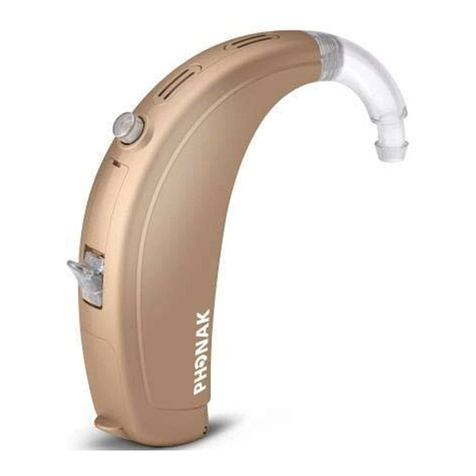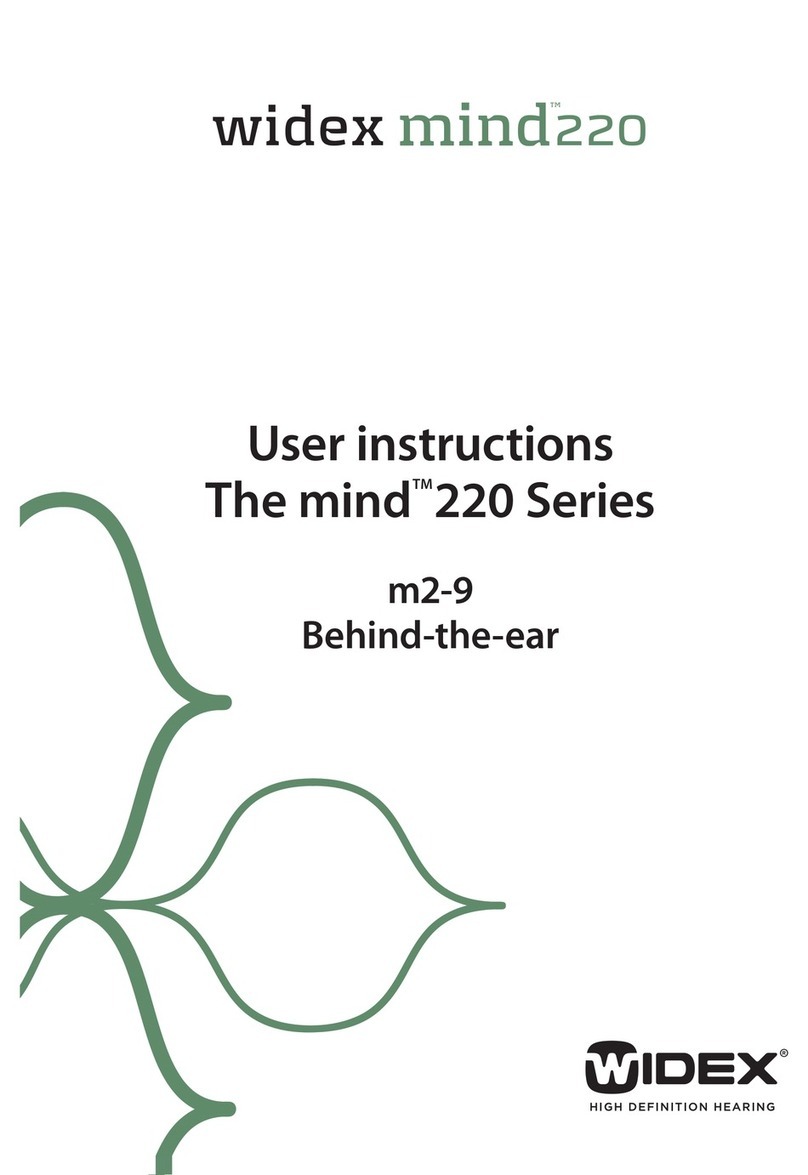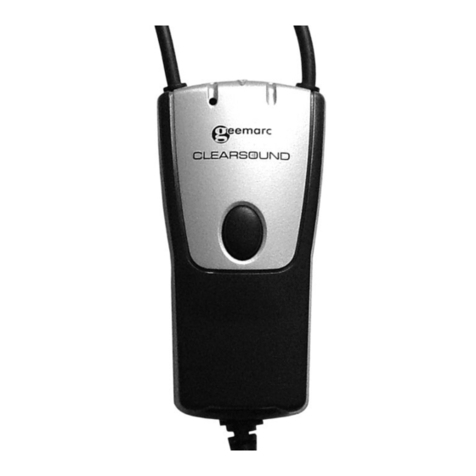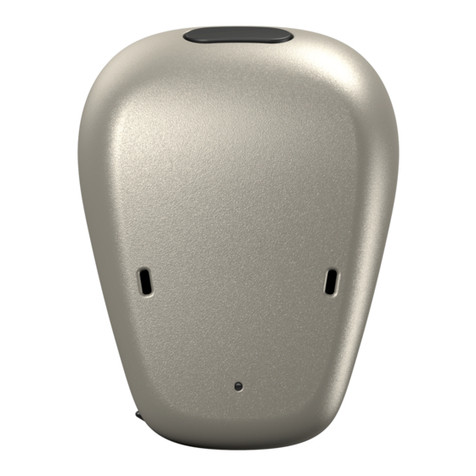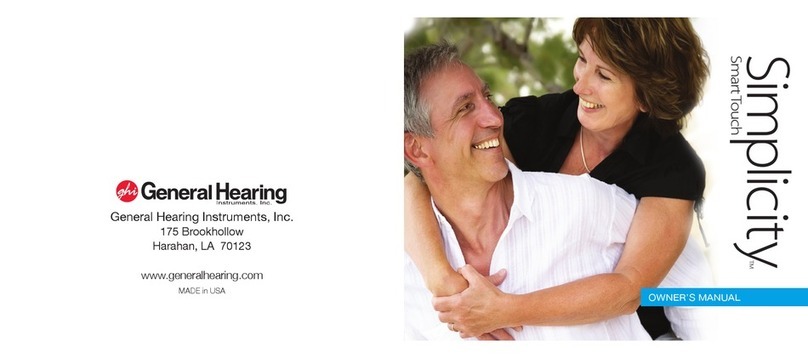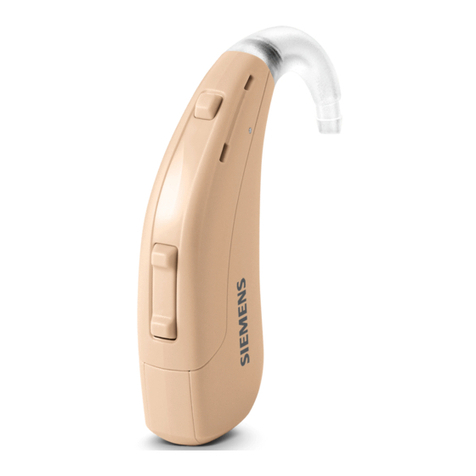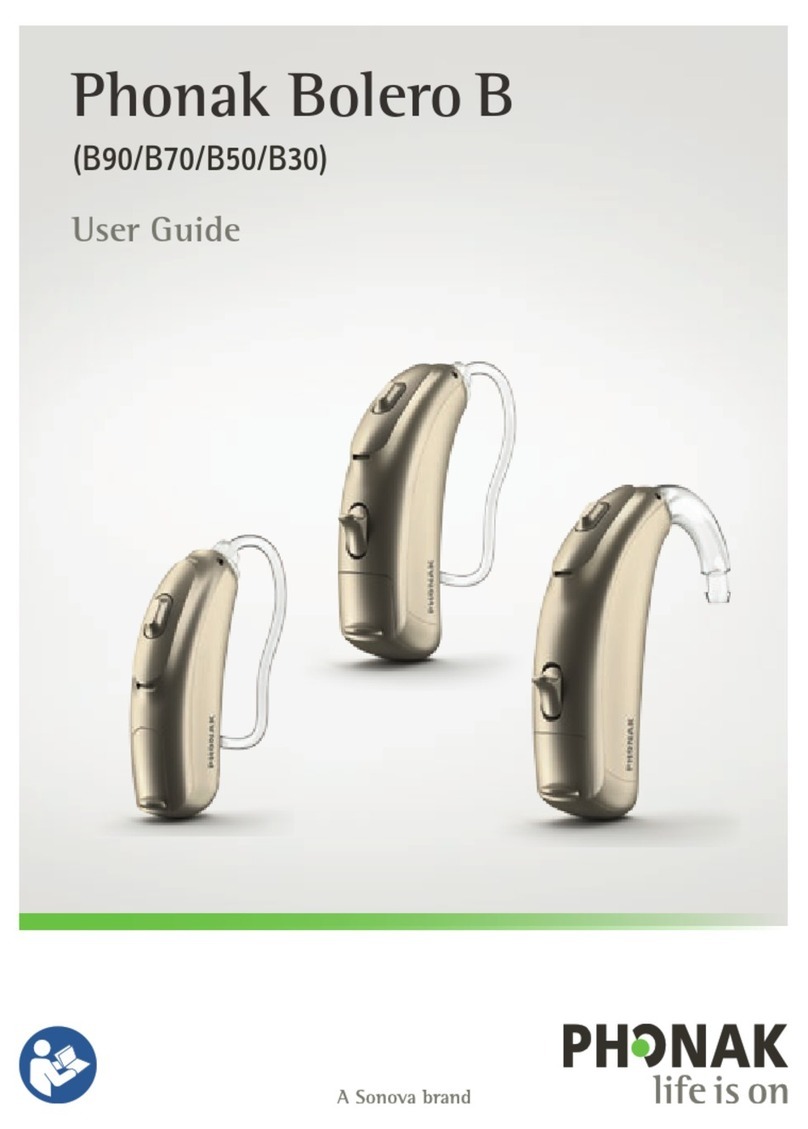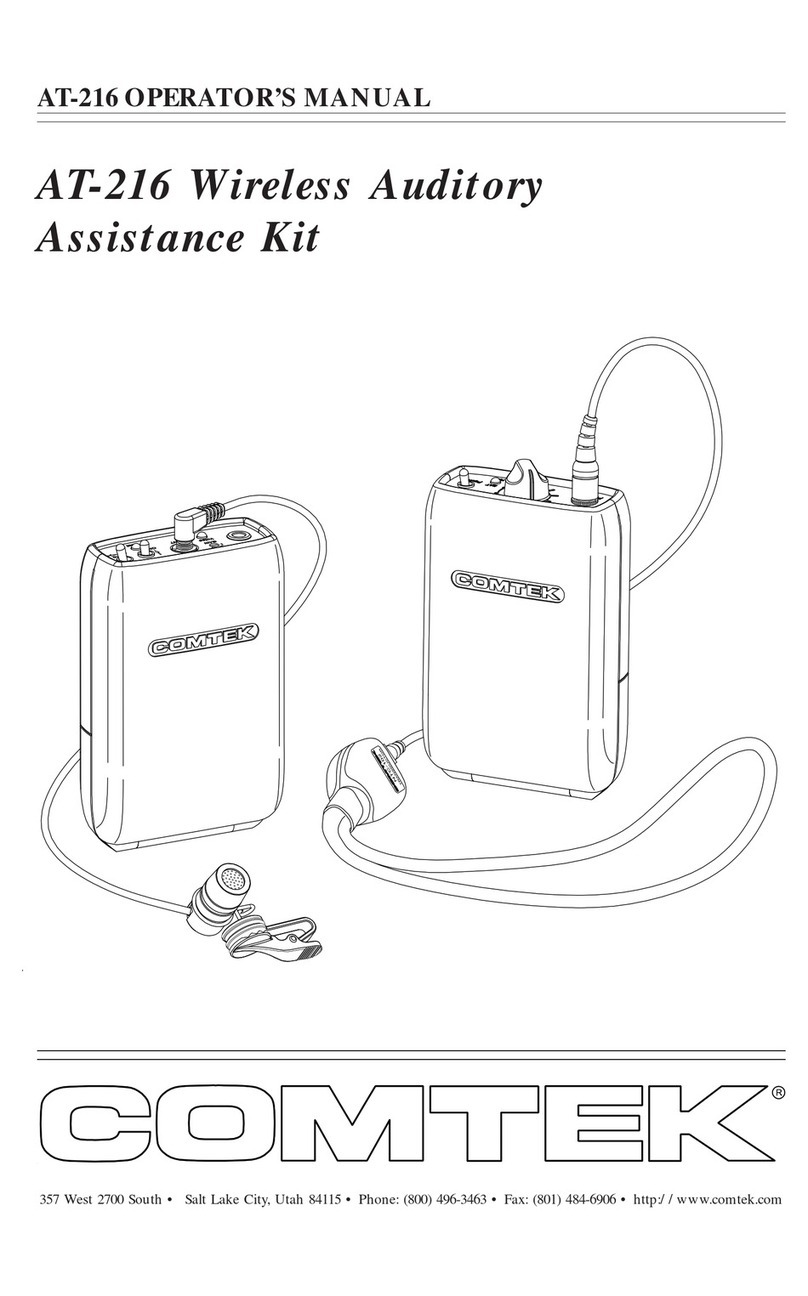Novasense RIC User manual

User Guide
RIC Products

2
English 3
Deutsch 19
Français 35
Italiano 51
Nederlands 67
Vlaams 83
Dansk 99
Português 115
Polski 131
Magyar 147
Русский 163

3
Content
EN
DE
FR
IT
NL
FL
DA
PT
PL
HU
RU
Content
Your RIC hearing instrument 4
Intended use 5
General notes on safety 6
Handling batteries 8
Turning your hearing instrument on/off 9
Changing the hearing program 10
Functionalities 11
Maintenance and care 12
Troubleshooting 16
Disposal information 17

Your RIC hearing instrument
4
NS P
(battery type 312)
① Receiver Unit
② Dome
③ Receiver Mold
④ Battery compartment
⑤ Push button
⑥ Charging contacts
⑦ Microphone cover
Your Hearing Care Professional offers an assortment of
receiver lengths and dome sizes to best fit your ear.
Your RIC hearing instrument

Intended use
5
EN
DE
FR
IT
NL
FL
DA
PT
PL
HU
RU
Hearing instruments are intended to help people with
hearing loss to hear better. Diagnosis and prescription of a
hearing instrument must be performed by hearing health
specialists, e.g. audiologists, ENT doctors or acousticians.
Read and follow the instructions of this user guide to
avoid injuries or damage to the hearing instruments.
Symbols:
Be aware to information marked with the warning symbol
WARNING, CAUTION or NOTICE!
WARNING points out a situation that could
lead to serious injuries, CAUTION indicates a
situation that could lead to minor and moderate
injuries.
NOTICE NOTICE indicates possible property damage.
Advice and tips on how to handle your device
better.
Instruction. Indicates that something has to be
done.
Indicates an option that not every hearing
instrument has. Ask your Hearing Care Profes-
sional to check off the relevant information.
Intended use

General notes on safety
6
NOTICE
Your hearing instruments are sensitive to extreme
heat, high humidity, strong magnetic fields
(> 0.1T), X-rays and mechanical stress.
Do not expose your hearing instruments to
extreme temperature or high humidity.
Do not leave them in direct sunlight.
Do not wear them in the shower or when you
apply make-up, perfume, aftershave, hairspray
or suntan lotion.
Do not wear your hearing instruments when
you are exposed to short-waves, a strong mag-
netic field, a high frequency field or X-rays.
Do not place your hearing instruments in a
microwave oven.
WARNING
Choking hazard posed by small parts.
Keep hearing instruments, batteries and acces-
sories out of children‘s reach.
If swallowed consult a physician or hospital im-
mediately.
If infants, small children or mentally disabled
persons need to wear hearing instruments
ensure adequate supervision.
General notes on safety

General notes on safety
7
EN
DE
FR
IT
NL
FL
DA
PT
PL
HU
RU
WARNING
Hazard of explosion!
Do not use your hearing instruments in areas
where there is a danger of explosions
(e.g. mining).
NOTICE
Leaking batteries damage the hearing instruments.
Turn the hearing instruments off when not in
use to preserve the battery.
Remove batteries when the instruments are not
in use for a prolonged period of time.
NOTICE
Batteries contain harmful substances that pollute
the environment.
Do not throw used batteries into household
trash.
Dispose batteries according to national regu-
lations or return them to your Hearing Care
Professional.
In some countries restrictions for the usage of
wireless equipment exist.
Refer to local authorities for further informa-
tion.

Handling batteries
8
If the sound becomes fainter or you
hear alerting signals, change the stan-
dard battery or charge the recharge-
able battery.
Always use the right size battery.
Charge rechargeable batteries before
first use.
Battery type
original size
Open the battery compartment
completely.
Remove the empty battery.
Insert the proper size battery.
Make sure that the "+" symbol on the bat-
tery points up as shown in the picture.
Close the battery compartment.
Handling batteries

Turning your hearing instrument on/off
9
EN
DE
FR
IT
NL
FL
DA
PT
PL
HU
RU
Via battery compartment
On
Close the battery compartment.
Off
Open the battery compartment.
Via push button
On
Press the push button for
2 seconds.
Off
Press the push button for
2 seconds.
Turning your hearing instrument
on/off

Changing the hearing program
10
Via push button
Press the push button.
The hearing instrument changes
to the next program.
Via remote control
Refer to the remote control user guide.
Hearing
program
Description of the hearing program
1
2
3
4
5
Changing the hearing program

Functionalities
11
EN
DE
FR
IT
NL
FL
DA
PT
PL
HU
RU
Your Hearing Care Professional can activate the following
functionalities.
e2e wireless
■ Allows the use of a remote control.
■ Automatically adjusts both hearing instruments
simultaneously to change the instrument set-
tings, e.g. volume or program.
The performance of the e2e wireless func-
tion may be affected by electromagnetic
interference – e.g. from a computer monitor
or fluorescent lamp system.
Move away from the source of interfer-
ence if you experience difficulty.
Power-on delay
Your hearing instrument is equipped with a "power-
on delay" feature which can be activated by your
Hearing Care Professional. This allows you to turn
the hearing instrument on with an automatic delay
of 6/12/18 seconds, so that you may insert the hear-
ing instrument into your ear without experiencing
unpleasant feedback (whistling).
Functionalities

Maintenance and care
12
Your hearing instruments are highly sensitive systems.
Proper care and handling will ensure the best possible
performance.
Clean instruments regularly to prevent damage to the
hearing instruments and to avoid health problems.
NOTICE
Do not put the hearing instruments
in water.
Clean your hearing instruments with a soft, dry tissue,
as necessary.
If the hearing instruments sound distorted or weak ask
your Hearing Care Professional to exchange the micro-
phone cover.
Place your hearing instruments in a "dry aid kit" with a
special moisture-attracting capsule overnight.
Ask your Hearing Care Professional for special care sets
and further information on how to keep your hearing
instruments in good condition.
Maintenance and care

Maintenance and care
13
EN
DE
FR
IT
NL
FL
DA
PT
PL
HU
RU
Domes and Receiver Molds
CAUTION
Risk of injury caused by incorrect use of receiver
unit and domes/receiver molds.
Always wear the receiver unit with a dome or
receiver mold.
Make sure that the dome/receiver mold is com-
pletely attached to the receiver unit.
If the dome/receiver mold remains in your ear,
have it removed by a medical professional.
Insert the receiver unit with the dome/receiver
mold carefully and not too deeply into the ear.
Use the receiver unit and the dome/receiver
mold only as described in this user guide.

Maintenance and care
14
Your hearing instruments have one of the following ear
pieces:
Dome Receiver mold
Clean domes and receiver molds right after taking
the hearing instruments off. This way cerumen can
not dry and harden.
Remove cerumen with a soft tissue. If necessary
moisten the tissue with a cerumen solvent.
Make sure that the
dome is completely
attached to the receiver
unit.
If the hearing instru-
ment sounds distorted
or weak, exchange the
dome.
Do not disassemble the
receiver mold yourself.
Ask your Hearing Care
Professional for help
when the receiver mold
needs extensive clean-
ing.

Maintenance and care
15
EN
DE
FR
IT
NL
FL
DA
PT
PL
HU
RU
Exchanging the receiver unit
The receiver unit can be changed as needed by
your Hearing Care Professional. If you need to
replace the receiver unit by yourself follow these
directions carefully.
Turn receiver unit 45° counterclockwise.
Remove receiver unit.
Join hearing instrument and receiver
unit together.
Marks need to coincide.
Turn receiver unit 45° clockwise.

Troubleshooting
16
Problem Possible solution
Sound is weak. Replace empty battery.
Clean dome/ receiver mold.
Exchange microphone cover.
Increase volume.
Hearing instrument
emits whistling
sounds.
Reinsert dome/receiver mold until it
fits securely.
Decrease volume.
Clean dome/receiver mold.
Sound is distorted. Decrease volume.
Replace empty battery.
Clean dome/receiver mold.
Hearing instrument
emits signal tones.
Gently close battey compartment
completely.
Replace empty battery.
Hearing instrument
does not work.
Turn hearing instrument on.
Gently close battery compartment
completely.
Replace empty battery.
Make sure battery is inserted
correctly.
Power-on delay is active. Wait
18 seconds and check again.
Consult your Hearing Care Professional if you encounter
further problems.
Troubleshooting

Disposal information
17
EN
DE
FR
IT
NL
FL
DA
PT
PL
HU
RU
Within the European Union, the marked equipment is cov-
ered by "Directive 2002/96/EC of the European
Paliament and of the Council of 27 January
2003 on waste electrical and electronical
equipment."
Amended by "Directive 2003/108/EC" (WEEE).
Recycle hearing instruments, batteries and ac-
cessories according to national regulations.
With the CE marking Siemens confirms compliance
with the European Directive 93/42/EEC concerning
medical devices.
For the products with e2e wireless 2.0 Siemens addition-
ally confirms compliance with the European Directive
99/5/EC (R&TTE) concerning radio and telecommunica-
tions terminal equipment.
Disposal information

18

19
Inhalt
EN
DE
FR
IT
NL
FL
DA
PT
PL
HU
RU
Inhalt
Ihr RIC-Hörsystem 20
Bestimmungsgemäßer Gebrauch 21
Allgemeine Hinweise zur Sicherheit 22
Handhabung der Batterien 25
Hörsystem ein-/ausschalten 26
Hörprogramm wechseln 27
Funktionen 28
Wartung und Pflege 29
Problembehandlung 33
Entsorgungshinweis 34

Ihr RIC-Hörsystem
20
NS P
(Batterietyp 312)
① Externer Hörer
② Ohrstück
③ Ohrpassstück
④ Batteriefach
⑤ Drucktaster
⑥ Ladekontakte
⑦ Mikrofonabdeckung
Bei Ihrem Hörgeräteakustiker können Sie aus einer Aus-
wahl von Hörern und Ohrstücken verschiedener Größe
das für Sie passende Modell auswählen.
Ihr RIC-Hörsystem
Table of contents
Languages:



